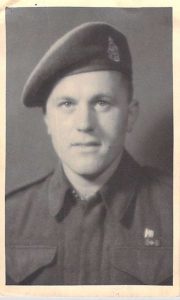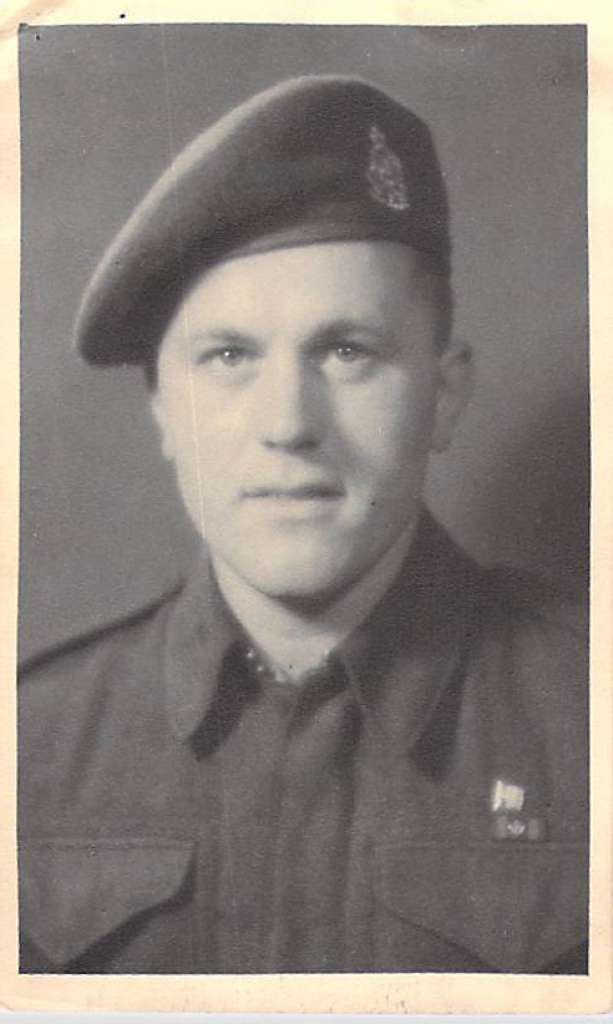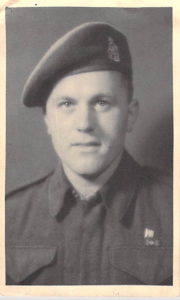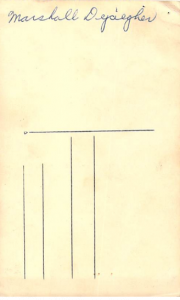

Born in Belgium, 9 January, 1924, the only son of Anna and Victor Dejaegher of Handzame, West Flanders, of 130 King St. East. The husband of Sheila (Scratcherd), the father of Michael, Karen (Irwin), Melcolm, Wratten and Peter predeceased by son Danny and daughter Judy.
Marshall enlisted in Windsor, ON., with the Kent Regt. at the age of 17 years on 7 October, 1941 (5’ 8”, brown hair and hazel eyes) he was living on Grant St., in Chatham, ON. at the time. He had gone to Windsor with a friend to enlist in the Navy but the recruiting officer doubting his age and told Marshall that if he could get a letter from his mother and co-signed by the Chief of Police in Chatham saying that he was in fact 18 the Navy would be glad to have him. Marshall knew that there was no possibility of that, but determined to “join up” waited a few days and went back this time to the Windsor armoury and the army took him right in. He completed his Basic Training at No. 12 BTC in Chatham. From BTC 12 he went to Wosley Barracks in London, ON., then on to MontreaL, PQ., and then to Camp Petawawa for tracked vehicle training. Fom there he departed for overseas with the 1st Hussars to England. Regiment moved overseas as part of the 5th Canadian Armoured Division in 1941 and continued training until D-Day.
Marshall’s time in England was taken up mostly in training as a tank driver and for a time in south-east England guarding that coast against a possible German invasion. After the defeat of the German Airforce during the Battle of Britian much of the attention of the Canadians went into “Schemes”, (training exercises ) for the eventual invasion of Europe.
By May of 1944 much of the Canadian 1st Division was being slowly moved to the south of England to eventually become part of Operation OVERLORD, the invasion on France through Normandy. In conversation with Marshall he recalled how he would be not just involved but became part of the invading force on 6 June, 1944.
One day in early June he and a number of his unit were put on a truck and proceeded to the area around Southampton. When the truck arrived at it’s destination the men were lined up and an officer appeared asking who could drive a tank. Marshall said he and a few others put up their hands. “Who can drive a Sherman tank?” the officer asked and a few hands went down. “Who can drive and repair a Sherman tank?” Marshall looked around and only his hand was still up. “Come with me.”, said the officer and he and Marshall departed to the harbor area and a LST (Landing Ship Tanks) waiting at the wharf. Going aboard the LST the officer said, “Well there is your tank.” Marshal said he looked at the tank and back at the offcer and said, “Sir, I’ve never seen a Sherman tank like that one”. What he was looking at was a Duplex-Drive (DD)modivied Sherman, one of the “Hobart Funnies” developed for the invasion. The DD tanks were one of the many specialised assault vehicles, collectively known as Hobart’s Funnies, devised to support the planned invasion of Europe
The DD tanks worked by erecting a ‘flotation screen’ around the tank, which enabled it to float, and had a propeller powered by the tank’s engine to drive them in the water. “This tank is short a driver and you are hear to drive it the crew Sergeant will show you what you need to know.”, said the officer and left him there. As ‘luck’ would have it the attack was moved off one day to rough water in the English Channel allowing Marshall the opportunity to familiarize himself with this strange version of a Sherman tank.
Marshall was, rightly so, concerned about the ability of a 30 ton Sherman tank’s ability to float. He asked one of the American Crew member on the LST, “How close will you guys get us to the shore?” The answer came, “Oh, no problem we’ll get you in close enough.” Not that reassured Marshall asked “How close will that be?” A reply of “We need about ten feet of water for the LST.”
On the evening of 5 June the invasion fleet set sail (6,939 vessels) for Normandy. As Marshall LST approached the shore the ship slowed and came to a stop. The front of the vessel opened and Marshall thought, This seems like a long way to the shore to be only ten feet deep. His was the third in line to disembark when the ramp went down and the first tank drove down, entered the sea and drove towards the shore. Likewise for the second tank and Marshall confidence had gone up by then. He engaged the drive and his tank proceeded to the ramp, down to the sea and made it a very short distance when the water-proof screen that was to supply the floatation collasped and he found his thirty ton tank sinking to the bottom, fifty feet below, at a terrifying rate of descent.
With the exception of the driver the rest of the crew had an easy escape route through the turret hatch to the surface and their floatation device made the assent to the surface a speedy one. The driver had a very small access above his head and he had to remove the floatation device to get through the small opening Keeping his wits he did and struggled to the surface close by his comrades, lucky for him since he could not swim. A couple of buddies grabbed hold of him and pulled him to shore.
Juno Beach was not a place you wanted to spend much time on and in Marshall’s case he had lost most of his gear getting out of the tank or on the swim to shore. “What I remember is a lot of firing on the beach. I was scared. Oh I was scared We all were”. His crew mates made a hasty advance across the beach but Marshall found himself pinned down for a time by enemy fire. “I still don’t know how they missed me. I still wonder how did I manage to go through all of that? Why did I survive when guys standing next to me were killed?” Eventually a Britsh officer the “Beach Master” for that section found him and directed him as to where to go.
Marshall would find another tank, the driver had been wounded so he took the controls. The fighting would be very hard for the next few days. German bunkers were a serious problem. “We were so vulnerable but the Germans had all kinds of protection their bunkers were like fortresses, made of concrete at least three feet thick and reinforced with steel with little slits to put their guns through. The only way to stop them was to blast them with a tanks cannon at close range or to have someone run up and to the bunker and throw a grenade inside and blow everyone up.” Two day after leaving the LST Marshall’s second tank hit a mine and he had to find another tank.
At 0730 hours 6th June, 1944, the 6 Cdn. Arm’d. Regt. (1H) in support of the 7 Cdn. Inf. Bde. of the 3 Cdn. Inf. Div. assaulted and overpowered the Hun’s beach defences between Courseulles-sur-mer and Bernières-sur-mer and after wiping out enemy resistance moved inland. One troop of “C” Squadron 6 CAR (1H) managed to reach the Caen-Bayeux Railway line, thus becoming the only unit of the allied invasion forces known to reach its final objective on D-Day.
Following the Normandy Landing, the Regiment took part in bitter battles in the bridgehead, the closing of the Falaise Gap and the clearing of the cross channel guns at Calais. The Regiment fought with distinction throughout Belgium and Holland and ended the war in Germany. During this period, the 1st Hussars won 72 decorations, certificates or mentions in dispatches – more than any other unit in the 1st Canadian Army. http://www.army.forces.gc.ca/1hussars/home-accueil-eng.asp
JUNE 11th—THE BLACK DAY OF THE HUSSARS (Battle of Le Mesnil-Patry).
At 0400 hours on Sunday, June 11th, Lieut. Col. R. J. Colwell returned from 2 CAB HQ with the news that the attack was definitely going in and that all crews would have 24 hours to prepare for it. However, at 0800 hours on that bright sunny June Sabbath a countermanding order was received to the effect that the attack must begin on that same day—11th June at 1300 hours.
That regiment (QOR), like the Hussars, will remember June 11th as a black day, not only because it cost almost a complete company—96 men—but also because it was such an unequal show, in which many brave men died accomplishing what at first glance seemed to be nothing.
http://warchronicle.com/canadian_armoured/regimentals_wwii/firsthussars_normandypt2.ht
Marshall stayed in Germany until 1946 before sailing back from the war on the Queen Elizabeth, landing in New York City, then by train to Chatham. After discharge from the service he settled in Chatham.
Marshall retired from Navistar International after twenty two years of work.
Marshall passed away Thursday, 14 August, 2014 at Riverview Gardens Nursing Home in Chatham at the age of ninety years. Interment at St. Anthony’s Cemetery, Chatham, ON. CDN-Obit. 16/08/14.
Interviewed Marshall 15 Mar. 2013. J. Hind. GOH-IS.


ADDITIONAL INFORMATION
| Sources | GOHS, http://www.army.forces.gc.ca/1hussars/home-accueil-eng.asp, LM-LP |
| Supplemental Information | Born in Belgium, 9 January, 1924, the only son of Anna and Victor Dejaegher of Handzame, West Flanders of 130 King Street East. The husband of Sheila (Scratcherd), the father of Michael, Karen (Irwin), Melcolm, Wratten and Peter predeceased by son Danny and daughter Judy. |
| Birthplace | Belgium |
Notice something wrong with this record? Or, do you have something to add? Report it using our online form.



